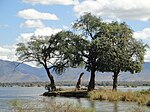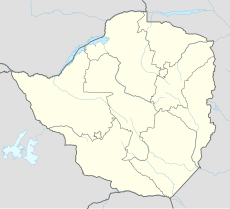List of World Heritage Sites in Zimbabwe
The United Nations Educational, Scientific and Cultural Organization (UNESCO) World Heritage Sites are places of importance to cultural or natural heritage as described in the UNESCO World Heritage Convention, established in 1972.[1] Cultural heritage consists of monuments (such as architectural works, monumental sculptures, or inscriptions), groups of buildings, and sites (including archaeological sites). Natural features (consisting of physical and biological formations), geological and physiographical formations (including habitats of threatened species of animals and plants), and natural sites which are important from the point of view of science, conservation, or natural beauty, are defined as natural heritage.[2] Zimbabwe accepted the convention on 16 August 1982.[3] There are five World Heritage Sites in Zimbabwe, with a further two on the tentative list.[3]
The first site in Zimbabwe to be inscribed to the list was the Mana Pools National Park, Sapi and Chewore Safari Areas, in 1984. The most recent site listed was the Matobo Hills, in 2003. Three sites in Zimbabwe are listed for their cultural and two for their natural properties.[3] Mosi-oa-Tunya / Victoria Falls is a transnational site, being shared with Zambia. Zimbabwe has served on the World Heritage Committee twice.[3]
World Heritage Sites
UNESCO lists sites under ten criteria; each entry must meet at least one of the criteria. Criteria i through vi are cultural, and vii through x are natural.[4]
| Site | Image | Location (province) | Year listed | UNESCO data | Description |
|---|---|---|---|---|---|
| Mana Pools National Park, Sapi and Chewore Safari Areas |  | Mashonaland West | 1984 | 302; vii, ix, x (natural) | This site comprises three contiguous protected areas along the Zambezi river. The Mana Pools are former river channels, created by alluvial deposits. In the dry season, the floodplains are an important refuge for large mammal communities, including the African elephant, hippopotamus, African buffalo, waterbuck, zebra, together with predators such as the lion, leopard, cheetah, as well as the Nile crocodile. Eastern black rhinoceroses used to live here at the time of inscription but the remaining animals have since been moved for safekeeping elsewhere.[5] |
| Great Zimbabwe National Monument |  | Masvingo | 1986 | 364; i, iii, vi (cultural) | Great Zimbabwe was founded by the Bantu Shona people in the 11th century. At its peak in the 14th century, the city had 10,000 inhabitants and was a major regional centre with trade links to China, Persia, and Kilwa Sultanate, on the east coast of Africa. It was abandoned c. 1450 because of overpopulation and deforestation, with power shifting to Khami. The archaeological complex comprises the Great Enclosure, Hill Ruins, and Valley Ruins. Six columns with Zimbabwe Birds were found in the ruins.[6] |
| Khami Ruins National Monument |  | Matabeleland North | 1986 | 365; iii, iv (cultural) | Khami was the capital of the Torwa dynasty between c. 1450 – c. 1650, after Great Zimbabwe had been abandoned. Like the latter, it was built using the dry stone technique and in a similar architectural style. It was an important regional centre of trade, with porcelain from China and Spain found among archaeological remains. It was abandoned in the 19th century. Because the site was not destroyed by treasure hunters, it provides an important insight into the history of the region.[7] |
| Mosi-oa-Tunya / Victoria Falls* |  | Matabeleland North | 1989 | 509; vii, viii (natural) | Along the border between Zimbabwe and Zambia, the Zambezi river creates a massive waterfall, with a width of 1,708 m (5,604 ft) and a maximum height of 108 m (354 ft). The river then continues through a series of narrow gorges, cut into basalt rock. The falling water creates mists that can be seen from tens of kilometres away. The gorges and the river islands serve as breeding grounds for the endangered Taita falcon and Verreaux's eagle.[8] |
| Matobo Hills |  | Matabeleland South | 2003 | 306rev; iii, v, vi (cultural) | The Matobo Hills feature numerous granite landforms, created over millions of years of erosion (Mother and Child Kopje pictured). People have inhabited the area for at least 500,000 years and interacted with the landforms in different ways. There are rock paintings dating at least 13,000 years back, representing one of the densest concentrations of rock art in southern Africa. Archaeological remains and rock art illustrate the life of the foraging people and the transition to agricultural societies. The area is still a centre of the Mwari religion.[9] |
Tentative list
In addition to sites inscribed on the World Heritage List, member states can maintain a list of tentative sites that they may consider for nomination. Nominations for the World Heritage List are only accepted if the site was previously listed on the tentative list.[10] Zimbabwe maintains two properties on its tentative list.[3]
| Site | Image | Location (province) | Year listed | UNESCO criteria | Description |
|---|---|---|---|---|---|
| Ziwa National Monument |  | Manicaland | 1997 | iii, iv, v (cultural) | Ziwa is an archaeological site with finds that span from the Stone Age to historical times. There are remains from hunter-gatherer societies, rock art sites, remains of settlements of agricultural societies, hill forts, enclosures, and remains of iron smelters.[11] |
| Naletale Cluster of Dzimbabwes |  | Matabeleland North | 2018 | ii, iii, iv (cultural) | This nomination comprises several clusters of settlements with dry stone walls. They date from the 16th to the 18th century. While not as monumental as the buildings in Great Zimbabwe or Khami, the walls in Naletale are renowned for their architectural finesse with fine ornamentation. The people of Naletale traded with the Portuguese, exchanging gold for items such as Chinese porcelain.[12] |
References
- ^ "The World Heritage Convention". UNESCO World Heritage Centre. Archived from the original on 27 August 2016. Retrieved 7 July 2019.
- ^ "Convention Concerning the Protection of the World Cultural and Natural Heritage". UNESCO World Heritage Centre. Archived from the original on 1 February 2021. Retrieved 3 February 2021.
- ^ a b c d e "Zimbabwe". UNESCO World Heritage Centre. Archived from the original on 12 July 2023. Retrieved 14 December 2023.
- ^ "UNESCO World Heritage Centre – The Criteria for Selection". UNESCO World Heritage Centre. Archived from the original on 12 June 2016. Retrieved 17 August 2018.
- ^ "Mana Pools National Park, Sapi and Chewore Safari Areas". UNESCO World Heritage Centre. Archived from the original on 13 December 2023. Retrieved 23 December 2023.
- ^ "Great Zimbabwe". UNESCO World Heritage Centre. Archived from the original on 24 December 2023. Retrieved 23 December 2023.
- ^ "Khami Ruins National Monument". UNESCO World Heritage Centre. Archived from the original on 28 October 2023. Retrieved 23 December 2023.
- ^ "Mosi-oa-Tunya / Victoria Falls". UNESCO World Heritage Centre. Archived from the original on 2 December 2023. Retrieved 23 December 2023.
- ^ "Matobo Hills". UNESCO World Heritage Centre. Archived from the original on 29 October 2023. Retrieved 23 December 2023.
- ^ "Tentative Lists". UNESCO World Heritage Centre. Archived from the original on 24 September 2005. Retrieved 7 October 2010.
- ^ "Ziwa National Monument". UNESCO World Heritage Centre. Archived from the original on 24 December 2022. Retrieved 22 August 2023.
- ^ "Naletale Cluster of Dzimbabwes". UNESCO World Heritage Centre. Archived from the original on 31 January 2023. Retrieved 22 August 2023.

